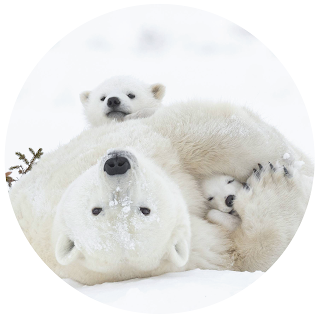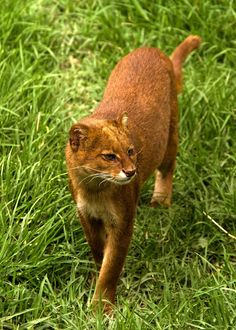Alaskan Polar Bear
 |
| a Polar Bear mom and her new born cubs |
Alaskan Polar Bear Recovery Plan
by Maya Mashiach
Polar Bear Conservation Management Plan
Listing Status: Threatened
Date: December 20, 2016
Location: Alaska
Plan Status: Final
Ecology:
Polar bears are typically found around the north in
the polar region. They are usually found near pack ice, a platform for
hunting and resting areas. Regardless of the time of year, they travel to
follow the pack ice as this is crucial to their optimal habitat. Polar
bears have large feet for them swim and walk along the ice. Males weigh around
600-1200 pounds and females weigh around 400-700 pounds. Females typically give
birth to twin cubs in her den where they stay until they grow big enough. Polar bear are generally solitary, with the exception of females with their cubs.
 |
| a map of the regions of the 19 polar bear subpopulations |
Geographic
and Population Changes:
There are 19 populations of polar bears. Two
of them are in Alaska being the Beaufort Sea population and the Chukchi
Sea population. The rest are found in other countries like Canada, Denmark, Norway, and Russia. The recovery plan only covers those in the US, that being Alaska. There are currently around 26,000 polar bears in the polar region and around 1000 bears found in the Alaskan region.
Causes of Listing and Threats to Existence:
The population of polar bears have been declining since early 1970. Initially, the decline was due to over harvest and sport hunting being extremely popular then. However, now the decline has shifted to be attributed to the impending climate change. Thinner ice and longer free ice periods are threatening the amount of land they have to utilize and the amount of hunting time they have. In addition, oil exploration is increasing in Alaska which is threatening their food opportunities and toxicity levels.
Recovery Plan:
The recovery plan focuses on the idea that polar bear decline is due to arctic warming and climate change. It mentions that it is out of their control to improve the climate, but there are opportunities to mitigate greenhouse gas emissions in an ecological manner. The following actions are outlined in their plan:
- limits global atmospheric levels of emissions to appropriate polar bear levels
- support the international conservation efforts through relationships
- manage conflicts between humans and polar bears
- manage subsistence harvest
- protect the den habitat for females and her cubs
- minimize oil spill risks for contamination
- continue monitoring and research
 |
| The sea-ice extent 1953-2015 in order to analyze the suitable period of conditions for polar bears. |
The plan's main goal is to ensure that polar bears remain wild on the planet and remain as a significant entity of the Arctic ecosystem as tie progresses. Stakeholders and Alaska Natives are crucial in maintaining the actions and goals in this plan seeing as they have a direct influence on the polar bears in the Alaskan region. Human impact is crucial to the plan. They lay out the ideas that maintaining human interactions and minimizing restrictions on human activities is important in order to keep a positive relationship.
Due to the uncertainty of the effects that these climatic changes have on polar bears, the Plan is laid out to be dynamic rather than static. As data is accumulated over time, the Plan needs to change to resolve the management that is being applied to this conservation. There will be three groups to maintain and change the Plan including a Human-Polar Bear conflicts working group, a communications working group, and a science working group.
What Can You Do?!:
Human influence is the biggest contributor to the conservation of polar bears. In order to preserve these species, anyone can partake in green methods as simple as driving less, eating local foods, and conserving energy at home. Anything and everything can contribute to climate change and any small thing can have a long term impact on the emissions and warming on earth. Polar bears are in need of our help, meaning they need everyone to take part in this global impact.
Fun Facts:
Polar Bears have black skin under their white fur!
Polar Bears can clean themselves by rolling in the snow!
Unlike other bears, Polar Bears do not hibernate!
Polar Bears can swim 60 miles without rest for food!
Polar Bears have built-in socks with stiff fur on the sole of their feet!
Other Resources:
Bromaghin, Jeffrey F. “Polar Bear Population Dynamics in the
Southern Beaufort Sea during a Period of Sea Ice Decline.” Species Profile for Polar Bear (Ursus Maritimus), Wiley Online
Library, ecos.fws.gov/ecp0/profile/speciesProfile?sId=4958#conservationPlans.
dfg.webmaster@alaska.gov. “Polar Bear (Ursus Maritimus)
Species Profile.” Polar Bear Species
Profile, Alaska Department of Fish and Game, www.adfg.alaska.gov/index.cfm?adfg=polarbear.main.
“Polar Bear Population Decline a Wake Up Call for Climate
Change Action.” WWF, World Wildlife
Fund,
www.worldwildlife.org/stories/polar-bear-population-decline-a-wake-up-call-for-climate-change-action.




Really like that you put in the fun facts section found it to be very interesting. its crazy to think they can swim 60 miles without stopping!
ReplyDelete~Sage Massey
The layout, fonts and colors of your blog make it very visually appealing and easy to follow. I love that the best way to help this animal is to stay green- that helps with so many things and being environmentally aware is so important. Also love the fun facts section.
ReplyDelete-Perry Nalle
I loved how you used the circular theme with your photos. That was a very creative touch. I also like that you used different colored text. It separated all of the information nicely so that I could tell when new information was going to be introduced.
ReplyDelete-Mckenna Moura
This blog was very organized and it made it easy to follow along. I loved the aesthetics of this blog! the visuals totally caught my attention and got my interested in this species. I also love how you made this blog fun and included cool fun facts.
ReplyDelete-Parker Ornellas
The aesthetics, color scheme and circularly cropped photos make this post a fun one to look at. I appreciate your in-depth focus on the many issues surrounding the polar bear's survival but also the light-hearted section you included with "fun facts." Great work!
ReplyDelete-Shannon O'Hehir
I really enjoy the color scheme and layout of the blog! The information was very written and I enjoyed reading it! It was also interesting to read about the different threats to the polar bears, because the main one I know is global climate change but none of the other threats to polar bears.
ReplyDelete-Christine Okimura
I loved the little fun facts portion at the end of the blog! Very cute information. It was sad reading that the main reason the polar bears are endangered is because of humans. Definitely going to make me rethink driving a lot!
ReplyDelete-Fiona McCallion
Your 'What Can You Do' section included a lot of ways that we can protect the species in our every day lives, which was really interesting to read. I also liked the fun facts section included in your blog!
ReplyDelete-Kristen Nagamatsu
I loved your organization and aesthetics of the images and text! The graphs and maps were useful and loved the fun facts portion!
ReplyDelete-Ali Murray
I loved the organization and formatting of your blog as well as the images. The "what can you do" section was also so helpful
ReplyDelete-Bryn Mulligan